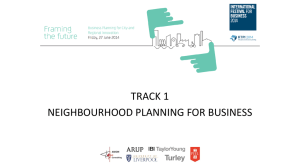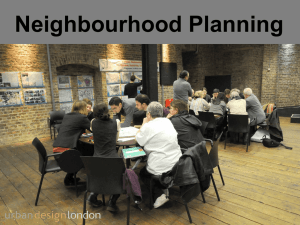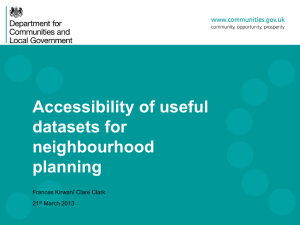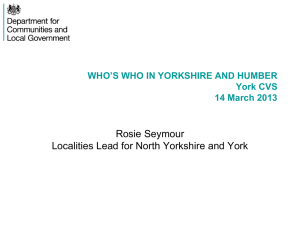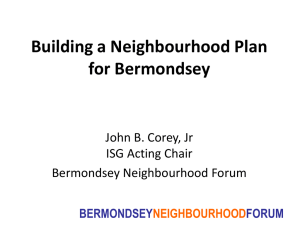Presentation - Neighbourhood Effects
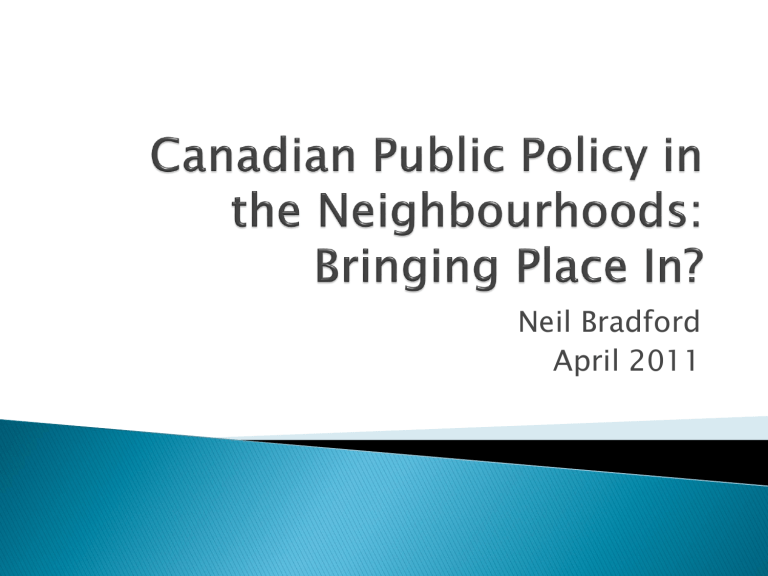
Neil Bradford
April 2011
4.
5.
1.
2.
3.
6.
Place Matters
Canadian Public Policy: “No There There”
Towards A New Awareness: Pressure Points and Local Knowledge
Bringing Place In, Canadian Style
Neighbourhood Policy Exemplars: The
Vancouver Agreement, Action for
Neighbourhood Change, Pathways to
Education
Moving Forward: Takeaways and Lessons
“ A central paradox of our age is that, as economic processes move increasingly to a global scale of operation, the centrality of the local is not diminished but is in fact enhanced.”
- Meric Gertler, Economic Geography, University of Toronto
Evolving body of international-comparative public policy knowledge about how localized territorial contexts shape high level outcomes (eg. OECD, 2006; Barca, 2009)
◦ Innovation: Geographic Knowledge Clustering
◦ Inclusion: Spatially Concentrated Poverty
◦ Sustainability: Metropolitan Ecological Footprint
◦ Diversity: The Intercultural City
Opportunities and obstacles both magnified by local dynamics
Canada presents an interesting conundrum …
◦ Strong sense of place and territory in national political culture, party system, and state institutions
◦ Yet, a country without a robust or strategic place-based policy tradition
◦ Instead, a cycle of one-offs, pilots, and demonstrations framed by a broader pattern of pork barrel regional transfers (see Lindblom’s
“disjointed incrementalism”)
“ Governments in Canada have lost their sense of place in policymaking … and needs to catch up with other countries on the issue of place”
- Prime Minister’s External Advisory Committee on Cities and Communities, 2006
What accounts for the disjuncture between territorial politics/local identities and spatially-blind public policy?
Large literature probes the nexus between Canadian politics and policy
Five factors = ‘place gap’
◦ Competitive and two-level Federalism: turf war and no municipal voices at the table
◦ National unity politics and one-size-fits-all policy: ethos of equalization and polarized debate between market or state
◦ Centralized government machinery: top-down design, delivery, and accountability
◦ No bureaucratic focal point: no whole of government unit and dominance of Finance and Treasury econometric models
◦ Data limitations: focus on administrative units not functional spaces, and limited evaluation capacity
Last decade, an emerging conversation …
◦ Lagging Productivity: research commercialization?
◦ Socio-Cultural Exclusion: recent immigrants?
◦ Democratic Deficit: civic engagement?
A place-based policy discussion emerging through various action-research networks:
◦ Innovation Systems Research Network (local clusters)
◦ Local Immigration Partnership Councils (multiculturalism from below)
◦ Vibrant Communities (anti-poverty community collaboration)
Canadian research on urban neighbourhoods?
Two key findings:
◦ Neighbourhood effects in Canada less evident than in Europe or American urban contexts (Willms, 2002; Statistics Canada, 2004)
◦ Individual and family factors remain central in shaping life chances, addressed through macro-level, universal social policy (eg. income support, health, education)
(Seguin and Divay, 2003; Dunn, 2008)
“ Knowing where there are neighbourhood effects and how they operate may not be as important as we think since there are other reasons for focusing on neighbourhoods or place-based initiatives” (Frieler , 2004)
◦ Piloting new approaches to service delivery or community development
◦ Increasing people’s confidence/capacity to participate in the community
◦ Promoting social cohesion and bottom up approaches to neighbourhood revitalization
◦ Encouraging a fairer distribution of resources and a greater impact by focusing resources
Canadian neighbourhood effects research concludes:
◦ “The Right Policy Mix”: Place and People Alignment
(Bradford 2005, Jenson, 2004)
◦ “Local Opportunity Structures”: Qualitative Action-Research
(Bernard et al. 2006, Dunn, 2008)
◦ “Learning from the Local”: Scaling-up Innovation
(Torjman, 2007, Sandercock, 2004)
“The main question is two-fold. First, it must be decided whether each general policy will have to be adjusted locally … second, it must be decided how different policies should be developed at the local level taking into account the different types of poverty and the characteristics of the neighbourhood” (Segin and Divay,
2003)
Each of the three place policy implications expressed through three leading Canadian neighbourhood initiatives:
◦ Vancouver Agreement: A tri-level model to align place and people policies for revitalization goals
◦ Action for Neighbourhood Change: An action-research five city pilot project to learn from the local about revitalization process
◦ Pathways to Education: Holistic and customized community-based strategy to support at risk youth in achieving educational and career development
All three place-based initiatives have won national, and in one case, international recognition for innovation in governance, and they have inspired replication across Canada
Tri-level five-year agreements to revitalize “neighbourhood in crisis” Downtown Eastside (DTES)
Bottom-up start
◦ City Neighbourhood Integrated Service Team and Four Pillars Healthy City
Coalition
Recognition that city and community resources (knowledge, networks, plans) must be leveraged through public policy
Federal Regional Development Agency takes risk to ‘go local’ and convenes the VA Neighbourhood Table
VA Principle and Narrative: “Revitalization without
Displacement”
Success Factors?
Problem-solving division of policy labour, not jurisdictional turf
Project Implementation via Task Teams (44 departments, agencies, from three governments work with and through CBOs)
The “mix that matters”
Outcome 1: VA incubated ‘in place’ innovations
◦ Insite Drug Centre
◦ Olympics Community Benefits Agreements
◦ Conversion of derelict hotels into mixed income housing
Outcome 2: VA delivered ‘system wide’ reforms
◦ Community policing practices in DTES
◦ DTES ‘social purchasing’ for government procurement
◦ Criminal code exemptions for injection site
Auditor General of Canada: VA is Canada’s “most promising governance model to meet community needs” and the “benchmark” for other cities
Federal “action learning project” in five distressed neighbourhoods
Federal-local connection through three national community organizations:
◦
United Way: convening/site management
◦
Tamarack Institute: community and resident engagement
◦
Caledon Institute: policy learning and policy dialogues
Success Factors?
Support for resident-defined and led neighbourhood change
Development and testing across five sites of “neighbourhood theory of change”
Outcome 1: ANC lesson drawing
◦ Evaluation keyed to collaborative process and community outcomes not individual department outputs
◦ Government requires organizational and cultural change to be local partner
Outcome 2: ANC legacies/hand-offs
◦ ANC local capacity leveraged further in subsequent municipal (eg. Toronto) and provincial neighbourhood strategies (British Columbia)
◦ ANC intellectual capital informed a Canadian “community of practice” eg.
“Federal Family on Community Collaboration”
Prime Minister’s Advisory Committee on Cities: “New approaches should seek to learn from ANC pilot program for community development” (p. 60)
2001 Community Health Centre in Toronto’s highest poverty and most racially diverse neighbourhood (Regent Park) focus on high school graduation as key to breaking cycle of poverty
Drop out rate twice city average, nearly three times in recent immigrant families
“Schools cannot be expected to solve problems of poverty rooted in social structure. Resources now allocated to lowvalue activities such as individual remediation could be used to support emerging work to strengthen communities.”
- Dr. Ben Levin, Former Ontario Deputy Minister of Education
Individual student/parent contract around four themes: advocacy, mentoring, tutoring, financing
Three success metrics:
◦ Absentee rate
◦ Academic at risk
◦ Drop out rate
2007 results?
◦ 50% decline in absenteeism
◦ 60% decline in academically at risk students
◦ 80% decline in dropout rate
Related social improvements in youth crime, teenage pregnancy, and integration of recent immigrants
(Boston Consulting Group Assessment, 2007)
Success Factors?
Customized student supports in contracts (Student Parent
Support Workers)
Holistic community network for advocacy, mentoring, tutoring, financing\
Outcome: Taking to Scale?
◦ Toronto United Way takes Pathways to four other “priority neighbourhoods”
◦ Federal government uses Pathways model for national initiative
“Graduation Nation” ($20 million/five years/20 neighbourhoods
Canada still a place policy and governance laggard
Recent developments send mixed signals …
◦ Federal disengagement “open federalism” (no interest in VA or ANC, only Pathways)
◦ Provincial anti-poverty strategies (Quebec, Ontario, New
Brunswick, Manitoba) build on local experiments
◦ Municipal/Community experimentation (Priority
Neighbourhoods, Poverty Reduction Roundtables)
◦ High level policy reports (both Senate and House of
Commons call for integrated ‘place and people’ strategies)
But the sum remains less than the individual parts; not joined-up, synergies missed …
“You create a system that’s not the usual ad hoc deliberations and serendipitous coming together of resources and people and interests. You actually define a problem and an agenda that is compelling and you put the pieces together so you can deal in a systematic way and create a long-term impact.”
- Community Activist
“We are in a classic ‘path dependency’ rut with poverty – governments go back and forth in the same policy rut simply because it is easier.”
Senator Hugh Segal
Institutionalize inter-governmental place-based collaboration through “comparative policy advantage”
◦ Vancouver Agreement, Action for Neighbourhood Change, and Pathways to Education each illustrate complementary roles and responsibilities
Federal
◦ Macro income supports, housing, immigration; and national convening and connecting roles
Provincial
◦ Land use planning framework and urban infrastructure; and integration of social/education/employment services
Municipal
◦ Social service delivery, public health, neighbourhood design, recreational spaces and community development
“Provinces have crucial strategic roles in reconciling policies and programs for places”
-
Prime Minister’s Advisory Committee on Cities and Communities, 2006
Canadian provinces govern at the intersection of people and place policies
◦ Work with Ottawa on people policies (income support, health, education)
◦ Work with municipalities on place policies (physical environment, community plan/neighbourhood design)
An institutional focal point for advancing neighbourhood public policy?
◦ The Provincial Council of the Federation needs a place lens
Stronger public policy in Canadian neighbourhoods depends on …
National Policy Networks
◦ Learning (systematic evaluation)
◦ Leveraging (inter-scalar capacity)
◦ Linking (pan-Canadian and international dialogue)
New Policy Leadership
◦ Political commitment (shared and patient)
◦ Bureaucratic facilitation (letting go and empowerment)
◦ Community engagement (from opposition to proposition)
◦ Action research (quantitative neighbourhood effects and qualitative opportunity pathways)


